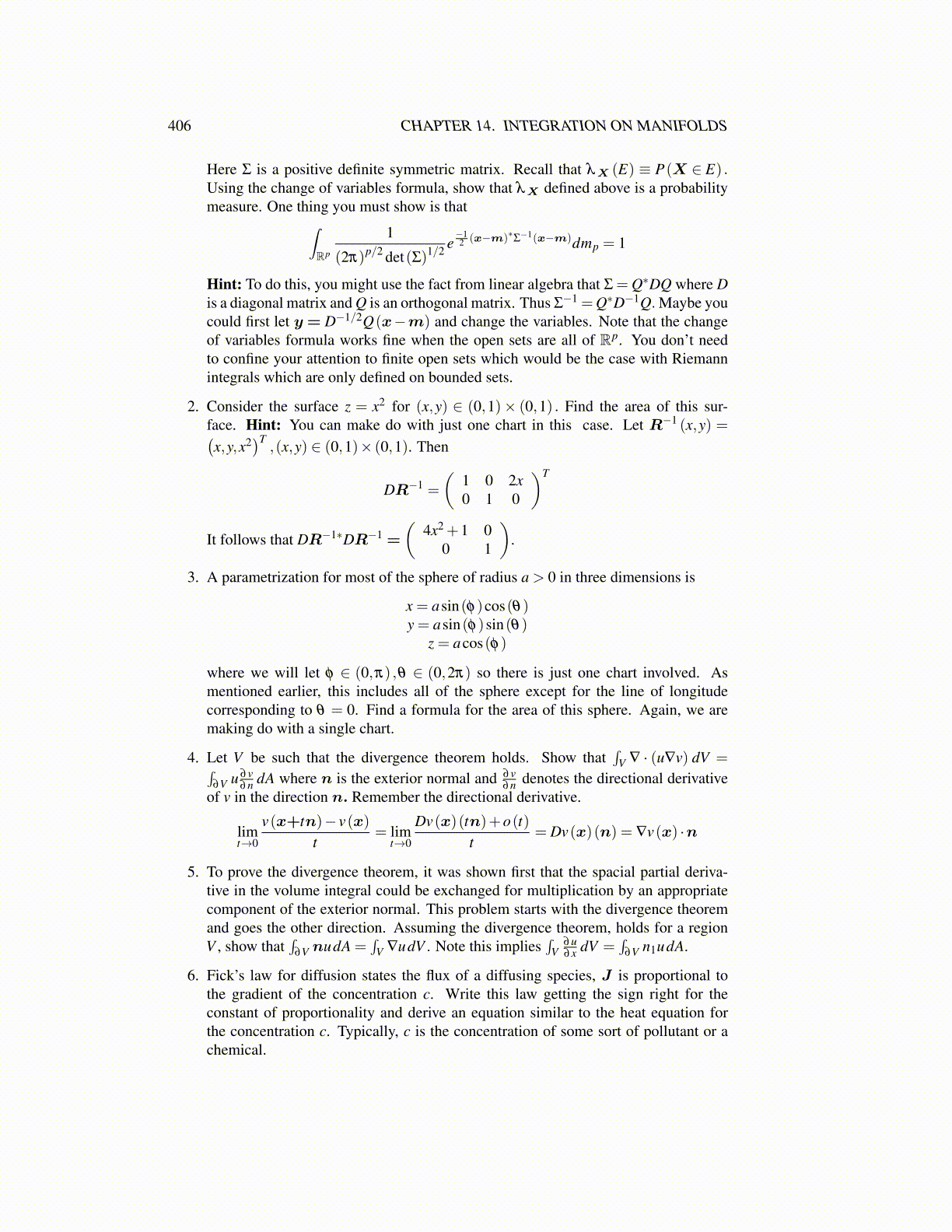
406 CHAPTER 14. INTEGRATION ON MANIFOLDS
Here Σ is a positive definite symmetric matrix. Recall that λX (E) ≡ P(X ∈ E) .Using the change of variables formula, show that λX defined above is a probabilitymeasure. One thing you must show is that∫
Rp
1
(2π)p/2 det(Σ)1/2 e−12 (x−m)∗Σ−1(x−m)dmp = 1
Hint: To do this, you might use the fact from linear algebra that Σ = Q∗DQ where Dis a diagonal matrix and Q is an orthogonal matrix. Thus Σ−1 =Q∗D−1Q. Maybe youcould first let y= D−1/2Q(x−m) and change the variables. Note that the changeof variables formula works fine when the open sets are all of Rp. You don’t needto confine your attention to finite open sets which would be the case with Riemannintegrals which are only defined on bounded sets.
2. Consider the surface z = x2 for (x,y) ∈ (0,1)× (0,1) . Find the area of this sur-face. Hint: You can make do with just one chart in this case. Let R−1 (x,y) =(x,y,x2
)T,(x,y) ∈ (0,1)× (0,1). Then
DR−1 =
(1 0 2x0 1 0
)T
It follows that DR−1∗DR−1 =
(4x2 +1 0
0 1
).
3. A parametrization for most of the sphere of radius a > 0 in three dimensions is
x = asin(φ)cos(θ)y = asin(φ)sin(θ)
z = acos(φ)
where we will let φ ∈ (0,π) ,θ ∈ (0,2π) so there is just one chart involved. Asmentioned earlier, this includes all of the sphere except for the line of longitudecorresponding to θ = 0. Find a formula for the area of this sphere. Again, we aremaking do with a single chart.
4. Let V be such that the divergence theorem holds. Show that∫
V ∇ · (u∇v) dV =∫∂V u ∂v
∂n dA where n is the exterior normal and ∂v∂n denotes the directional derivative
of v in the direction n. Remember the directional derivative.
limt→0
v(x+tn)− v(x)t
= limt→0
Dv(x)(tn)+o(t)t
= Dv(x)(n) = ∇v(x) ·n
5. To prove the divergence theorem, it was shown first that the spacial partial deriva-tive in the volume integral could be exchanged for multiplication by an appropriatecomponent of the exterior normal. This problem starts with the divergence theoremand goes the other direction. Assuming the divergence theorem, holds for a regionV , show that
∫∂V nudA =
∫V ∇udV . Note this implies
∫V
∂u∂x dV =
∫∂V n1udA.
6. Fick’s law for diffusion states the flux of a diffusing species, J is proportional tothe gradient of the concentration c. Write this law getting the sign right for theconstant of proportionality and derive an equation similar to the heat equation forthe concentration c. Typically, c is the concentration of some sort of pollutant or achemical.